Blog & Latest Updates
Fly Fishing Articles
Insects by Common Name


Animal Kingdom Animalia (Animals)
Taxonomic Navigation -?-
Kingdom Animalia (Animals)
| Phylum in Animalia | ||
| AnnelidaWorms and Leeches | 0 | 2 |
| ArthropodaArthropods | 0 | 122 |
| ChordataVertebrates | 0 | 4 |
| Mollusca | 0 | 6 |
| PlatyhelminthesFlatworms | 0 | 0 |
Common Name
| Match | Common Name |
| Animals |
This is page 72 of specimens of Animalia. Visit the main Animalia page for:
- The behavior and habitat of Animalia.
- 131 underwater pictures of Animalia.
Pictures of 1264 Animal Specimens:
Kogotus nonus Stonefly Nymph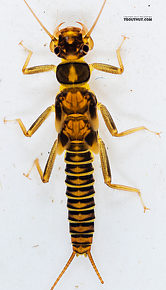 View 10 Pictures
View 10 Pictures
 View 10 Pictures
View 10 PicturesCollected July 28, 2019 from Mystery Creek #199 in Washington
Added to Troutnut.com by Troutnut on July 30, 2019
Added to Troutnut.com by Troutnut on July 30, 2019
Maccaffertium (March Browns and Cahills) Mayfly Nymph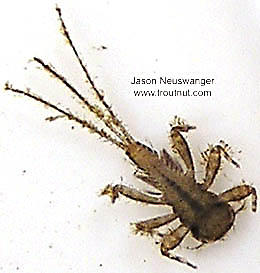 View 2 PicturesI saw under a microscope that the gills on this specimen aren't tracheated.
View 2 PicturesI saw under a microscope that the gills on this specimen aren't tracheated.
 View 2 PicturesI saw under a microscope that the gills on this specimen aren't tracheated.
View 2 PicturesI saw under a microscope that the gills on this specimen aren't tracheated.Collected February 7, 2004 from unknown in Wisconsin
Added to Troutnut.com by Troutnut on January 25, 2006
Added to Troutnut.com by Troutnut on January 25, 2006
Male Heptagenia culacantha Mayfly Spinner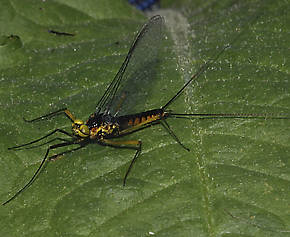 View 1 PicturesThis photo was provided by guide Eric Naguski along with the following comments, "I took this photo just upstream of Three Mile Island on the east shore of the Susquehanna River just below where the Swatara Creek enters. The Susquehanna is not an easy river to sample for bugs in my opinion. It is very large and pushes a lot of water. Especially in the spring when you would collect mature culacantha nymphs. And I don't believe that there are a ton of these Heptageniids around. Also the people who are doing most of the sampling like myself are doing so for water quality monitoring work so they only take the specimens down to genus-level taxonomy".
View 1 PicturesThis photo was provided by guide Eric Naguski along with the following comments, "I took this photo just upstream of Three Mile Island on the east shore of the Susquehanna River just below where the Swatara Creek enters. The Susquehanna is not an easy river to sample for bugs in my opinion. It is very large and pushes a lot of water. Especially in the spring when you would collect mature culacantha nymphs. And I don't believe that there are a ton of these Heptageniids around. Also the people who are doing most of the sampling like myself are doing so for water quality monitoring work so they only take the specimens down to genus-level taxonomy".
 View 1 PicturesThis photo was provided by guide Eric Naguski along with the following comments, "I took this photo just upstream of Three Mile Island on the east shore of the Susquehanna River just below where the Swatara Creek enters. The Susquehanna is not an easy river to sample for bugs in my opinion. It is very large and pushes a lot of water. Especially in the spring when you would collect mature culacantha nymphs. And I don't believe that there are a ton of these Heptageniids around. Also the people who are doing most of the sampling like myself are doing so for water quality monitoring work so they only take the specimens down to genus-level taxonomy".
View 1 PicturesThis photo was provided by guide Eric Naguski along with the following comments, "I took this photo just upstream of Three Mile Island on the east shore of the Susquehanna River just below where the Swatara Creek enters. The Susquehanna is not an easy river to sample for bugs in my opinion. It is very large and pushes a lot of water. Especially in the spring when you would collect mature culacantha nymphs. And I don't believe that there are a ton of these Heptageniids around. Also the people who are doing most of the sampling like myself are doing so for water quality monitoring work so they only take the specimens down to genus-level taxonomy".Collected October 22, 2011 from the Susquehanna River in Pennsylvania
Added to Troutnut.com by Entoman on February 10, 2012
Added to Troutnut.com by Entoman on February 10, 2012
Pteronarcys californica (Giant Salmonfly) Stonefly Nymph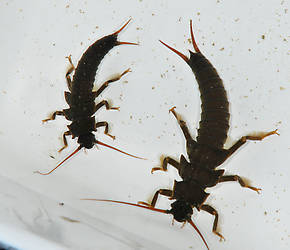 View 2 PicturesHere are two size classes of Pteronarcys nymphs. These probably represent two different generations. The largest will probably emerge next spring and the other in two years. There is probably another generation, smaller, I did not collect. In a Canadian study they discovered Pteronarcys eggs do not all hatch simultaneously but hatch for a period of nearly two years, making their egg/nymphal life 5 years. The other photo is of a curled nymph, a typical response to disturbance.
View 2 PicturesHere are two size classes of Pteronarcys nymphs. These probably represent two different generations. The largest will probably emerge next spring and the other in two years. There is probably another generation, smaller, I did not collect. In a Canadian study they discovered Pteronarcys eggs do not all hatch simultaneously but hatch for a period of nearly two years, making their egg/nymphal life 5 years. The other photo is of a curled nymph, a typical response to disturbance.
 View 2 PicturesHere are two size classes of Pteronarcys nymphs. These probably represent two different generations. The largest will probably emerge next spring and the other in two years. There is probably another generation, smaller, I did not collect. In a Canadian study they discovered Pteronarcys eggs do not all hatch simultaneously but hatch for a period of nearly two years, making their egg/nymphal life 5 years. The other photo is of a curled nymph, a typical response to disturbance.
View 2 PicturesHere are two size classes of Pteronarcys nymphs. These probably represent two different generations. The largest will probably emerge next spring and the other in two years. There is probably another generation, smaller, I did not collect. In a Canadian study they discovered Pteronarcys eggs do not all hatch simultaneously but hatch for a period of nearly two years, making their egg/nymphal life 5 years. The other photo is of a curled nymph, a typical response to disturbance.Collected August 10, 2011 from the Touchet River in Washington
Added to Troutnut.com by Bnewell on August 10, 2011
Added to Troutnut.com by Bnewell on August 10, 2011
Male Epeorus pleuralis (Quill Gordon) Mayfly Dun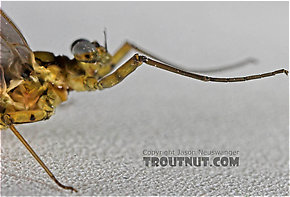 View 9 Pictures
View 9 Pictures
 View 9 Pictures
View 9 PicturesCollected May 7, 2005 from the Beaverkill River in New York
Added to Troutnut.com by Troutnut on May 16, 2006
Added to Troutnut.com by Troutnut on May 16, 2006
Male Epeorus frisoni Mayfly Dun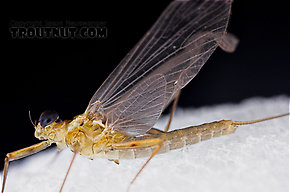 View 2 PicturesI collected this male dun together with a female spinner, a female dun, and another male dun. I photographed this bedraggled one, larger than the other male, to show some of the greatest size variation within the species.
View 2 PicturesI collected this male dun together with a female spinner, a female dun, and another male dun. I photographed this bedraggled one, larger than the other male, to show some of the greatest size variation within the species.
 View 2 PicturesI collected this male dun together with a female spinner, a female dun, and another male dun. I photographed this bedraggled one, larger than the other male, to show some of the greatest size variation within the species.
View 2 PicturesI collected this male dun together with a female spinner, a female dun, and another male dun. I photographed this bedraggled one, larger than the other male, to show some of the greatest size variation within the species.Collected September 6, 2006 from Mystery Creek #23 in New York
Added to Troutnut.com by Troutnut on October 3, 2006
Added to Troutnut.com by Troutnut on October 3, 2006
Hesperoperla pacifica (Golden Stone) Stonefly Nymph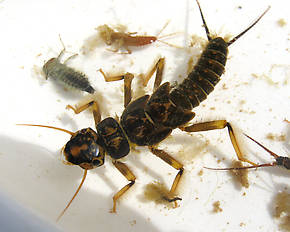 View 1 PicturesThis monster started to feed within a few minutes of sharing the inspection tray with its victims. This nymph is a voracious predator of small invertebrates and has even been noted for feeding on small fish and salmonid alevins. The niche it fills in fast water is equivalent to the Dragonfly nymphs that inhabit slower water.
View 1 PicturesThis monster started to feed within a few minutes of sharing the inspection tray with its victims. This nymph is a voracious predator of small invertebrates and has even been noted for feeding on small fish and salmonid alevins. The niche it fills in fast water is equivalent to the Dragonfly nymphs that inhabit slower water.
Hesperoperla pacifica nymphs are easily distinguished from other western perlids by the presence of anal gills (obfuscated by algae in the tray) in combination with an hour glass shaped pale mark on the front of their heads.
 View 1 PicturesThis monster started to feed within a few minutes of sharing the inspection tray with its victims. This nymph is a voracious predator of small invertebrates and has even been noted for feeding on small fish and salmonid alevins. The niche it fills in fast water is equivalent to the Dragonfly nymphs that inhabit slower water.
View 1 PicturesThis monster started to feed within a few minutes of sharing the inspection tray with its victims. This nymph is a voracious predator of small invertebrates and has even been noted for feeding on small fish and salmonid alevins. The niche it fills in fast water is equivalent to the Dragonfly nymphs that inhabit slower water.Hesperoperla pacifica nymphs are easily distinguished from other western perlids by the presence of anal gills (obfuscated by algae in the tray) in combination with an hour glass shaped pale mark on the front of their heads.
Collected March 22, 2013 from the Lower Yuba River in CA
Added to Troutnut.com by Entoman on April 4, 2013
Added to Troutnut.com by Entoman on April 4, 2013
Heptagenia solitaria (Ginger Quill) Mayfly Nymph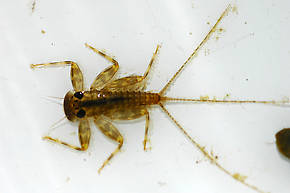 View 1 Pictures
View 1 Pictures
 View 1 Pictures
View 1 PicturesCollected February 27, 2005 from the Flathead River-lower in Montana
Added to Troutnut.com by Bnewell on June 28, 2011
Added to Troutnut.com by Bnewell on June 28, 2011
Taenionema atlanticum (Willowfly) Stonefly Nymph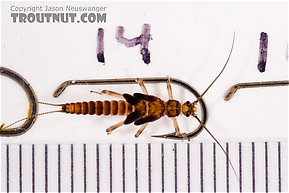 View 7 Pictures
View 7 Pictures
 View 7 Pictures
View 7 PicturesCollected April 1, 2007 from Mystery Creek #62 in New York
Added to Troutnut.com by Troutnut on April 3, 2007
Added to Troutnut.com by Troutnut on April 3, 2007
Female Brachycentrus americanus (American Grannom) Caddisfly Adult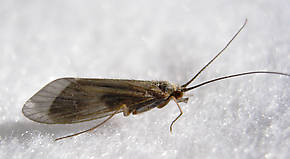 View 1 PicturesSize 11 mm. Prior to this photo the specimen dropped its large egg mass that was a very dark (almost black) olive sphere almost twice the diameter of the abdomen. Notice the abdomen visible through the wings is both thickened and shortened post egg drop.
View 1 PicturesSize 11 mm. Prior to this photo the specimen dropped its large egg mass that was a very dark (almost black) olive sphere almost twice the diameter of the abdomen. Notice the abdomen visible through the wings is both thickened and shortened post egg drop.
 View 1 PicturesSize 11 mm. Prior to this photo the specimen dropped its large egg mass that was a very dark (almost black) olive sphere almost twice the diameter of the abdomen. Notice the abdomen visible through the wings is both thickened and shortened post egg drop.
View 1 PicturesSize 11 mm. Prior to this photo the specimen dropped its large egg mass that was a very dark (almost black) olive sphere almost twice the diameter of the abdomen. Notice the abdomen visible through the wings is both thickened and shortened post egg drop.Collected October 15, 2011 from the Fall River in California
Added to Troutnut.com by Entoman on October 21, 2011
Added to Troutnut.com by Entoman on October 21, 2011
Top 10 Fly Hatches
Top Gift Shop Designs
Eat mayflies.
Top Insect Specimens
Miscellaneous Sites
Troutnut.com is copyright © 2004-2024 Jason
Neuswanger (email Jason). See my FAQ for information about use of my images.
 privacy policy
privacy policy
